Pit Oven
by Susan Labiste
This year at the Rattlesnake Rendezvous, a delicious chicken
came straight from under the ground. The Rendezvous is a 3-day
primitive technology gathering. For the duration of the event,
participants live as closely to a Stone Age life as they are able.
For most of us that meant no metal cookware. For me, it meant
it was time to experiment with a cooking technology which predated
both metal and clay pots. I made an underground pit oven.
Cooking underground is a time honored tradition in many parts
of the world. The imu of Hawaii is perhaps
the most popularized example in the United States. The pit oven
is also a Native California tradition, with many Native American
groups cooking food underground.
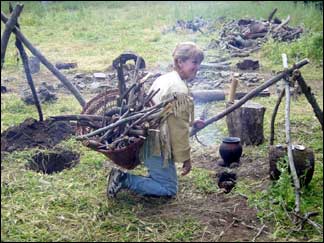 To create a pit oven,
fire wood was the first consideration. Enough wood was needed
for an eight hour fire. I set off with my conical burden basket,
and found its design ideal for gathering wood. Usually I am juggling
wood pieces, dropping some of what is in my arms as I try to gather
more. With the burden basket and a tumpline, I was able to use
my hands to toss gathered pieces into the basket behind my back.
To my amazement, it seemed to stack itself in there without falling
out, even when it was quite full.
To create a pit oven,
fire wood was the first consideration. Enough wood was needed
for an eight hour fire. I set off with my conical burden basket,
and found its design ideal for gathering wood. Usually I am juggling
wood pieces, dropping some of what is in my arms as I try to gather
more. With the burden basket and a tumpline, I was able to use
my hands to toss gathered pieces into the basket behind my back.
To my amazement, it seemed to stack itself in there without falling
out, even when it was quite full.
At about 9:30 a.m., I started a cooking fire and added ten
grapefruit-sized spherical cooking rocks, and 6 larger (7 to 12
inch) somewhat flattened stones. These volcanic rocks were of
vesicular basalt, and fairly heavy despite the presence of holes.
Vesicular basalt is ideal for cooking because it can withstand
high temperatures without exploding. If my morning hours hadn't
already been promised to another task, I would have started the
fire in a pre-dug pit rather than on the top of the ground.
At about 11:30 a.m., I began digging a hole adjacent to the
fire. The hole was about 2 feet wide, and 1 1/2 feet deep. The
sides were nearly vertical. It was stony ground, so I was glad
for my modern shovel. When the pit was complete, I moved the larger
heated rocks into the hole to line both the base and lower sides.
I then built a second fire in the pit. As the fires heated the
rocks and the earth surrounding the oven, I gathering greenery.
I chopped thistle and placed it in two piles near the fire. I
chose the thistle because it was non-native (weedy), plentiful,
and it was nontoxic.
A Cornish game hen was washed. An apple was placed in its body
cavity to add flavor and moisture. I had already shucked some
sweet corn for roasting, and placed the husks in water to keep
them moist. The husks from four cobs (base intact) were used to
completely wrap the Cornish game hen. Willow bark was bound over
the husks to keep them tightly sealed.
At 1:30 p.m., the rocks had been heating a total of 4 hours
and the fire 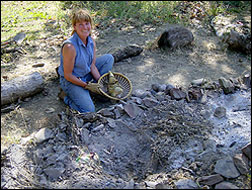 had burned down to
coals. Using the shovel, most of the coals were removed. Half
of the thistle was placed in the pit. It created a layer of thistle
measuring about 4 inches thick. The husk-wrapped chicken was placed
on top of the thistle. The second half of the thistle was placed
over the chicken, and the heated cooking stones were placed around
the wrapped chicken. The entire oven was now crackling and steaming
from the heat. With some hesitation, I shoveled earth over the
top of the thistle. I was hoping the dirt wouldn't penetrate the
thistle and the wrap. I didn't want gritty chicken.
had burned down to
coals. Using the shovel, most of the coals were removed. Half
of the thistle was placed in the pit. It created a layer of thistle
measuring about 4 inches thick. The husk-wrapped chicken was placed
on top of the thistle. The second half of the thistle was placed
over the chicken, and the heated cooking stones were placed around
the wrapped chicken. The entire oven was now crackling and steaming
from the heat. With some hesitation, I shoveled earth over the
top of the thistle. I was hoping the dirt wouldn't penetrate the
thistle and the wrap. I didn't want gritty chicken.
The fire was raked over the top of the pit and rekindled. It
was kept burning until 5:30 p.m. when it was allowed to die down
to a few coals. The pit was then uncovered carefully, moving earth
and thistle from the center to the sides. The corn husk wrapped
chicken was intact inside, steaming hot and damp with moisture
from the thistles and husks. When the wrapping was removed, there
was no sign of dirt, and the chicken was very moist, tender, and
quite flavorful.
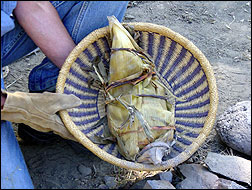
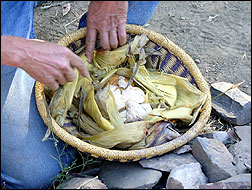
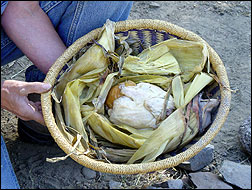
Pit oven cooking is generally done when a large number of people
are being fed. It require lots of fuel, plentiful rock of a type
capable of withstanding heat, and considerable labor to dig the
hole. Regardless of the impracticality of such a small pit oven,
it was an enjoyable experiment I would encourage readers to try.

E-mail your comments to "Susan Labiste" at labiste_s@sbcglobal.net
PrimitiveWays
Home Page
We hope the information on the PrimitiveWays website is both instructional and enjoyable. Understand that no warranty or guarantee is included. We expect adults to act responsibly and children to be supervised by a responsible adult. If you use the information on this site to create your own projects or if you try techniques described on PrimitiveWays, behave in accordance with applicable laws, and think about the sustainability of natural resources. Using tools or techniques described on PrimitiveWays can be dangerous with exposure to heavy, sharp or pointed objects, fire, stone tools and hazards present in outdoor settings. Without proper care and caution, or if done incorrectly, there is a risk of property damage, personal injury or even death. So, be advised: Anyone using any information provided on the PrimitiveWays website assumes responsibility for using proper care and caution to protect property, the life, health and safety of himself or herself and all others. He or she expressly assumes all risk of harm or damage to all persons or property proximately caused by the use of this information.
© PrimitiveWays 2013
 To create a pit oven,
fire wood was the first consideration. Enough wood was needed
for an eight hour fire. I set off with my conical burden basket,
and found its design ideal for gathering wood. Usually I am juggling
wood pieces, dropping some of what is in my arms as I try to gather
more. With the burden basket and a tumpline, I was able to use
my hands to toss gathered pieces into the basket behind my back.
To my amazement, it seemed to stack itself in there without falling
out, even when it was quite full.
To create a pit oven,
fire wood was the first consideration. Enough wood was needed
for an eight hour fire. I set off with my conical burden basket,
and found its design ideal for gathering wood. Usually I am juggling
wood pieces, dropping some of what is in my arms as I try to gather
more. With the burden basket and a tumpline, I was able to use
my hands to toss gathered pieces into the basket behind my back.
To my amazement, it seemed to stack itself in there without falling
out, even when it was quite full. had burned down to
coals. Using the shovel, most of the coals were removed. Half
of the thistle was placed in the pit. It created a layer of thistle
measuring about 4 inches thick. The husk-wrapped chicken was placed
on top of the thistle. The second half of the thistle was placed
over the chicken, and the heated cooking stones were placed around
the wrapped chicken. The entire oven was now crackling and steaming
from the heat. With some hesitation, I shoveled earth over the
top of the thistle. I was hoping the dirt wouldn't penetrate the
thistle and the wrap. I didn't want gritty chicken.
had burned down to
coals. Using the shovel, most of the coals were removed. Half
of the thistle was placed in the pit. It created a layer of thistle
measuring about 4 inches thick. The husk-wrapped chicken was placed
on top of the thistle. The second half of the thistle was placed
over the chicken, and the heated cooking stones were placed around
the wrapped chicken. The entire oven was now crackling and steaming
from the heat. With some hesitation, I shoveled earth over the
top of the thistle. I was hoping the dirt wouldn't penetrate the
thistle and the wrap. I didn't want gritty chicken.

